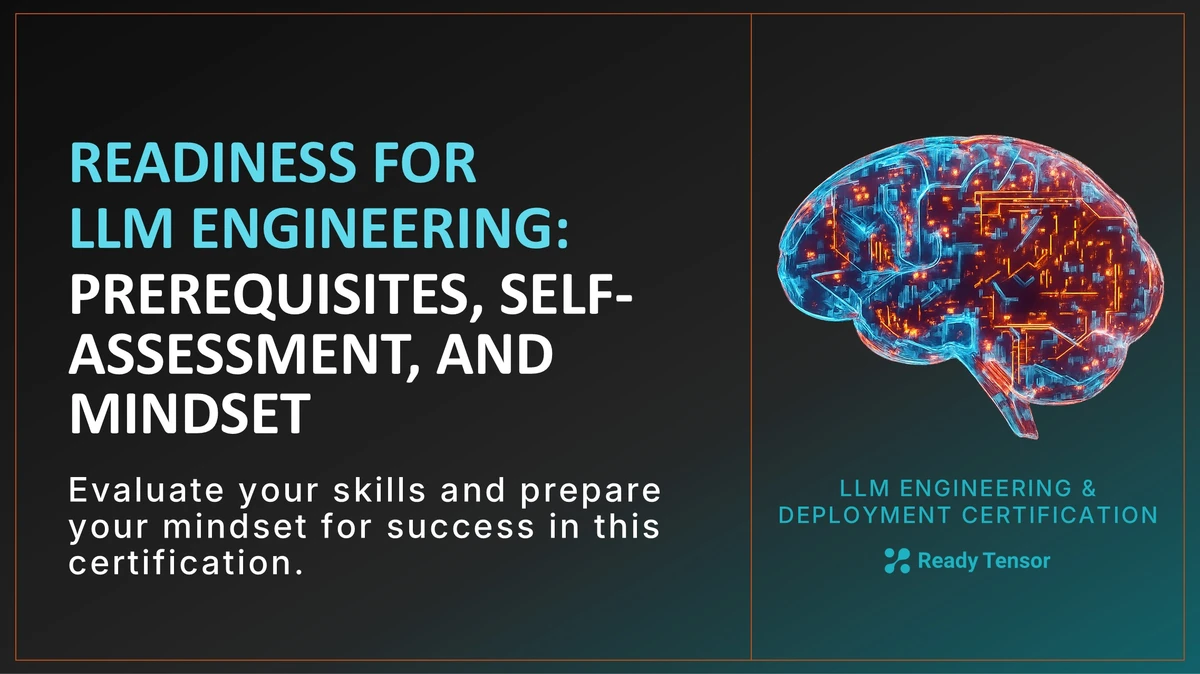
⬅️ Previous - Certification Program Overview
This certification moves quickly from fundamentals to hands-on fine-tuning, optimization, and deployment. You’ll be working with open-source models, real code, and cloud tools — just like a production AI engineer would.
That means you’ll get the most out of this program if you already have a working foundation in Python, machine learning concepts, and basic LLM operations.
Think of this as your pre-flight check: if you’re ready here, you’ll fly through the program smoothly.
You don’t need to be an expert, but you should be comfortable with the essentials below.
| Skill Area | What You Should Know |
|---|---|
| Python (Intermediate) | Writing scripts, functions, and classes; debugging; working with virtual environments. |
| Command Line & Git | Navigating directories, cloning repositories, running scripts, and managing dependencies. |
| Transformer & NLP Basics | Understanding encoder–decoder architectures, attention mechanisms, and tasks like text classification, summarization, and question answering. |
| PyTorch & Hugging Face | Using PyTorch for neural network training and inference; working with the Hugging Face transformers library to load, fine-tune, and evaluate models. |
| LLM Fundamentals | Understanding tokens, embeddings, model context length, and prompt–response cycles. |
| Vector Databases & RAG Systems | Knowing how vector search works, and how retrieval-augmented generation connects external knowledge to LLMs. |
| Agentic AI Concepts | Making LLM calls, chaining multiple steps or functions, and understanding reasoning patterns (chain-of-thought, ReAct, etc.). |
If you find a few of these unfamiliar — that’s fine.
This isn’t a gate; it’s a guide. Use this list to target what to review before moving ahead.
Now that you know what's expected, it's time to test your readiness.
The LLM Engineering Readiness Check Quiz is a short self-assessment designed to help you identify your strengths and areas for review.
It takes about 5-7 minutes and covers the prerequisite skills outlined above. Your results will show you exactly where you stand and what to focus on if you need to prepare.
The quiz isn’t meant to block your progress — it’s here to make sure you get the most out of the experience.
Many skills can be refreshed quickly using YouTube tutorials, Hugging Face docs, or the free Agentic AI Developer Program for agentic concepts.
A lower score isn’t a setback — it’s a signal to step up your preparation.
Technical knowledge can be learned.
What really defines success in this program, and in your AI career, is your willingness to learn continuously.
In traditional education, you learned first and applied later.
Now, in AI, learning is the work.
Every one of us started out knowing none of this — Python, transformers, embeddings — all of it was new once.
What matters is your willingness to learn, not where you begin.
The learners who succeed in this program are the ones who keep going when something feels unfamiliar.
Documentation, experimentation, and curiosity are your most valuable tools. Use them to your advantage.
Once you’ve completed the readiness quiz and reviewed any weak areas, head to the next lesson —
Curriculum & Roadmap — to see how each week’s lessons build toward your two capstone projects.
And remember — this isn’t about knowing everything before you start.
It’s about being ready to learn continuously. The most valuable skill you’ll ever build as an AI engineer is the ability to teach yourself new things and stay curious along the way.
Your best teacher is you.
Welcome aboard, once again. Now let’s get you ready to build.